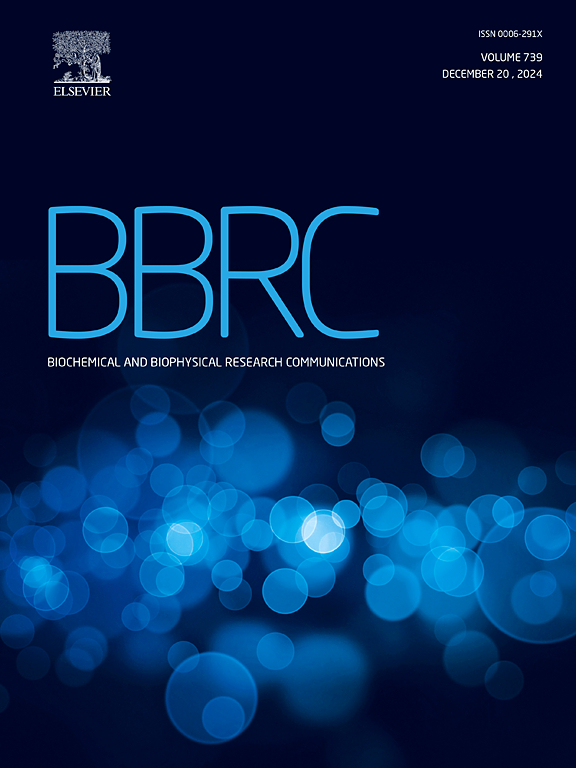微RNA miR-199a-3p通过靶向激活的肝星状细胞中的CDK17减轻肝纤维化
IF 2.5
3区 生物学
Q3 BIOCHEMISTRY & MOLECULAR BIOLOGY
Biochemical and biophysical research communications
Pub Date : 2024-09-20
DOI:10.1016/j.bbrc.2024.150727
引用次数: 0
摘要
肝纤维化是大多数慢性肝病的共同特征,对健康构成重大威胁,其病因多种多样。虽然微小核糖核酸(miRNA)通过直接调控靶基因显示出了良好的抗肝纤维化潜力,但人们对其治疗机制仍不完全了解。在这项研究中,我们发现了最初在抗肝纤维化外泌体中发现的 miR-199a,它是一种关键的调节因子,可在小鼠模型中缓解硫代乙酰胺诱导的肝纤维化。与体内作用一致,miR-199a模拟物能有效抑制人肝星状细胞(HSCs)--肝纤维化的核心驱动因素--的活化和功能,并抑制体外HSC增殖和活力。值得注意的是,miR-199a-3p 是通过直接下调其生物相关靶标--细胞周期蛋白依赖性激酶 17(CDK17)来发挥这些抗纤维化作用的。在活化的造血干细胞中仅消耗 CDK17 就足以抑制它们的活化、功能、增殖和活力,这反映了 miR-199a 模拟处理的效果。相反,CDK17的过表达逆转了miR-199a模拟物处理诱导的所有细胞效应。我们的研究结果突显了miR-199a-3p-CDK17调控轴,并表明靶向激活的造血干细胞中的CDK17可能是治疗肝纤维化的一种有前景的策略。本文章由计算机程序翻译,如有差异,请以英文原文为准。
MicroRNA miR-199a-3p alleviates liver fibrosis by targeting CDK17 in activated hepatic stellate cells
Liver fibrosis, a common feature of most chronic liver diseases, poses significant health risks and results from various etiologies. While microRNAs (miRNAs) have demonstrated promising anti-fibrotic potential through the direct regulation of target genes, their therapeutic mechanisms remain incompletely understood. In this study, we identified miR-199a, initially discovered in anti-liver fibrotic exosomes, as a key modulator that alleviates thioacetamide-induced liver fibrosis in a mouse model. Consistent with its in vivo effects, treatment with an miR-199a mimic effectively inhibited the activation and function of human hepatic stellate cells (HSCs)-central drivers of liver fibrosis-as well as HSC proliferation and viability in vitro. Notably, miR-199a-3p exerted these anti-fibrotic effects by directly downregulating its biologically relevant target, cyclin-dependent kinase 17 (CDK17). Depletion of CDK17 alone in activated HSCs was sufficient to suppress their activation, function, proliferation, and viability, mirroring the effects of miR-199a mimic treatment. Conversely, overexpression of CDK17 reversed all cellular effects induced by miR-199a mimic treatment. Our findings highlight the miR-199a-3p-CDK17 regulatory axis and suggest that targeting CDK17 in activated HSCs could be a promising therapeutic strategy for liver fibrosis.
求助全文
通过发布文献求助,成功后即可免费获取论文全文。
去求助
来源期刊
CiteScore
6.10
自引率
0.00%
发文量
1400
审稿时长
14 days
期刊介绍:
Biochemical and Biophysical Research Communications is the premier international journal devoted to the very rapid dissemination of timely and significant experimental results in diverse fields of biological research. The development of the "Breakthroughs and Views" section brings the minireview format to the journal, and issues often contain collections of special interest manuscripts. BBRC is published weekly (52 issues/year).Research Areas now include: Biochemistry; biophysics; cell biology; developmental biology; immunology
; molecular biology; neurobiology; plant biology and proteomics

 求助内容:
求助内容: 应助结果提醒方式:
应助结果提醒方式:


